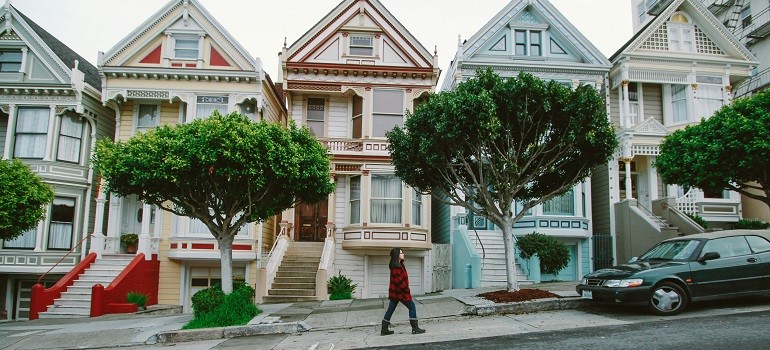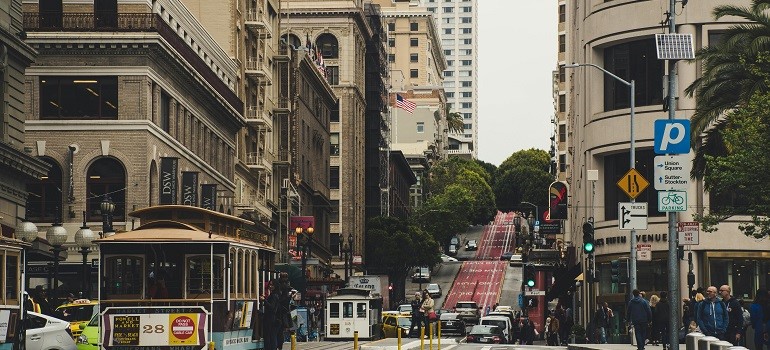If you’ve been keeping an eye on Bay Area headlines, you probably already guessed it — San Francisco keeps getting wealthier. The latest U.S. Census and market data confirm it: San Francisco is even richer than last year. Incomes are rising, homes are selling for millions, and rent prices continue to test everyone’s budgets. Yet the story isn’t just about the money. It’s about how the city is shifting — from new tech investments to slower population growth and changing neighborhood trends. If you’re planning a move, local moving companies in the Bay Area like Upline Moving CA can help you handle relocation logistics while you focus on exploring your new city. This is your quick, clear look at what’s really going on in 2025.
Income levels keep climbing in San Francisco
Let’s start with what’s driving all the buzz — income. San Francisco’s median household income now sits around $139,800, far above the national average. In neighborhoods like Marina and Pacific Heights, many households are comfortably crossing the $150,000 mark. Younger professionals are earning more too, with the 25–44 group averaging close to $199,000 a year. That explains the packed brunch spots, Tesla-lined streets, and full reservation books at every new restaurant.

If you’re moving locally within the Bay Area to get closer to work or family, local movers in San Francisco Bay Area can make that relocation easier and faster. For anyone relocating, it’s good to know that a six-figure salary here often feels middle-of-the-road. Comparing salaries nationally doesn’t help much; San Francisco runs on its own financial scale.
Housing prices remain high with subtle shifts
Buying a home here? Bring patience — and a big budget. The median sale price hovers around $1.4 million, with listings lasting just a few weeks. More homes are selling this year, a sign that buyers are adjusting to high prices rather than waiting them out. Condos in SoMa and South Beach have softened slightly, but single-family homes in Pacific Heights and Alamo Square remain as competitive as ever.
HOA fees for condos can reach $1,000 a month, so it pays to check the fine print before falling in love with the view. If you’re relocating from another part of California, experienced long distance movers in San Francisco can help coordinate the process efficiently. For most people, jumbo loans are still standard practice, and cash buyers continue to dominate high-end sales
Renters still face high prices
If buying feels out of reach, renting isn’t exactly easy either. The average apartment now costs about $3,700 per month, and one-bedroom units in central neighborhoods like SoMa or the Mission can easily hit $3,400. Areas such as the Outer Sunset or Ingleside offer better deals but come with longer commutes and cooler weather.

Since return-to-office policies brought workers back downtown, demand has surged again, especially near major transit lines. If you’re moving across state lines for a job or new lifestyle, trusted interstate movers in San Francisco can help you settle into the right rental quickly. If you’re planning to rent, compare listings by ZIP code and ask about fees like parking or pets — they add up fast. In San Francisco, budgeting a little extra for rent isn’t optional; it’s survival.
The down payment dilemma
Let’s talk about what might be the toughest part of buying in 2025: the down payment. On average, San Franciscans put down about 26% of the home’s price — roughly $375,000 for that $1.4 million property. For first-time buyers, that number can feel out of reach. Larger down payments do help with better rates and stronger offers, but they require serious savings. For renters ready to make that leap into ownership, professional apartment movers in San Francisco can make the transition between rental and new home simple and organized. High-cost loan limits and property taxes also push costs up.
Planning to buy? In a city like this, preparation is half the battle:
- get pre-approved early
- compare loan options
- work with a local lender who understands jumbo financing
Choosing the right neighborhood
Each San Francisco neighborhood tells a different story. Pacific Heights, Cow Hollow, and the Marina still top the charts when it comes to living in San Francisco, with median home prices well above $2.5 million. South Beach condos hover closer to $1.1 million, but expect hefty HOA dues — often near $900 a month.

For something more affordable, Outer Sunset and Ingleside usually list homes closer to $1 million. Renters can find better deals in these areas too, especially farther from BART or Muni hubs. Fog, parking, and lot size all factor into what you get for your money. The key is to compare prices within each ZIP code, not across the whole city.
Who qualifies for local housing programs
Not everyone moving here earns a tech-level paycheck, and that’s where San Francisco’s housing programs come in
- The 2025 Area Median Income (AMI) for a family of four sits at $186,600. To qualify for “low-income” programs, that household would need to earn below $149,300.
- The Mayor’s Office of Housing updates these numbers every spring, and they decide who’s eligible for below-market-rate rentals and ownership opportunities.
If you’re new to the area, understanding how these programs work can be tricky. Hiring experienced art movers in San Francisco is a good example of how specialized local services make life easier here — and that same principle applies to navigating local housing programs with expert help. If you’re relocating on a moderate income, check the official AMI charts before applying.
A city growing slower, but still golden
The city’s population has changed a lot in the last couple of year. As of January 2025, about 842,000 people call San Francisco home — roughly 31,000 fewer than before the pandemic. Some residents moved to surrounding counties where housing is cheaper, while others left the state altogether.
New construction remains slow, with fewer than 3,000 new housing units approved last year. That keeps competition high, even as total population dips. Families still love quieter areas like West Portal and the Outer Richmond, while downtown depends heavily on office attendance.
Tech and AI: The real reason San Francisco is even richer than last year?
Tech is far from dead here — it just looks different. In the first half of 2025 alone, Bay Area startups pulled in about $29 billion in AI investment. New companies are filling office spaces in SoMa, South Beach, and Hayes Valley — now nicknamed “Cerebral Valley.” While the AI boom fuels housing demand in those areas, overall hiring is more selective than it was in 2019. The city’s unemployment rate sits around 4.3%, steady but still above its pre-pandemic lows.
If you’re arriving soon, take some time to explore things to do in San Francisco in the fall once you settle in — it’s one of the best ways to connect with the community while job hunting or apartment searching.
Planning your move with real 2025 data
Before packing boxes, take time to look at real numbers.
- Check income data from the Census Bureau, housing trends from Redfin, and rent averages from Zillow.
- Review San Francisco AMI charts if you’re interested in affordable housing programs.
- Keep an eye on California’s population and housing reports for long-term trends.

Once you have a clear picture, set a realistic budget that includes:
- taxes
- HOA fees
- insurance
- parking
- utilities
Pre-approval and savings make a huge difference when it’s time to make an offer. In this city, planning ahead is the best way to stay confident and competitive.
Find the most economical way towards your new home!
There’s no doubt — San Francisco is even richer than last year. The numbers show it in every corner, from higher incomes to resilient home prices and fast-moving rentals. AI money keeps flowing, and the city continues to attract ambitious professionals. Yet it’s not just about wealth. It’s about how the city keeps evolving — and how people moving here can find their place in it. Whether you’re buying, renting, or just exploring, the key is to know the facts, plan realistically, and embrace San Francisco for what it is: bold, expensive, and always one step ahead.
Tags
Subscribe to Upline Moving's Blog









